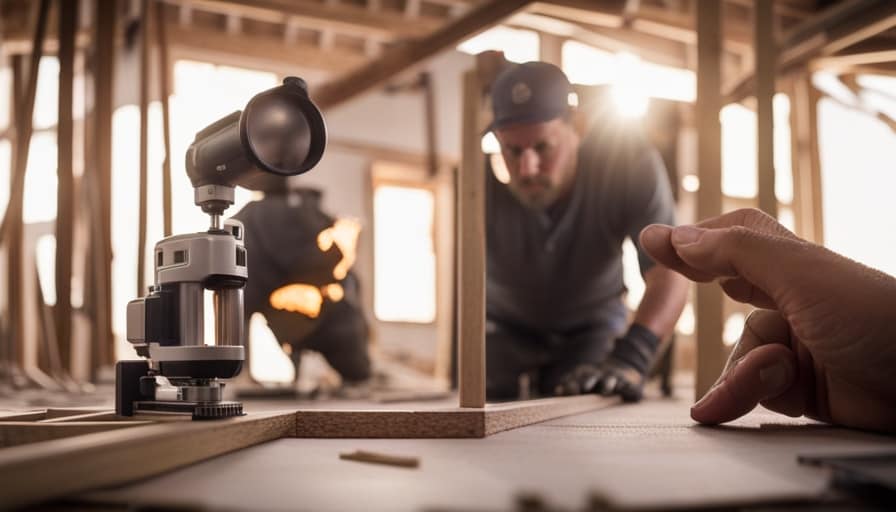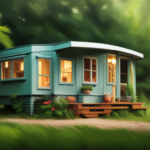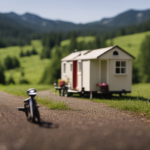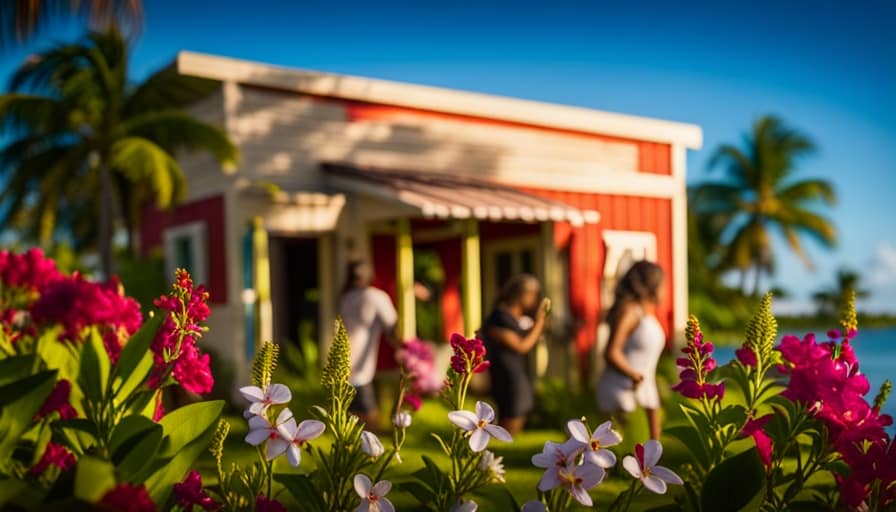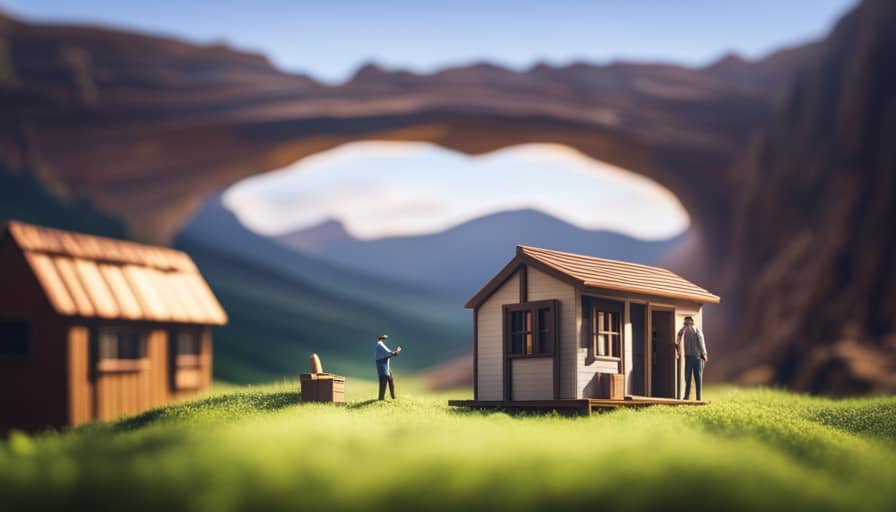Prepare yourself for an thrilling adventure exploring the fascinating realm of mobile tiny homes!
In this article, we, your trusty guides, will take you on an exploration of the seven essential aspects that make these compact dwellings so captivating.
From the freedom to travel wherever your heart desires, to the ingenious design modifications that maximize functionality and style, we’ve got you covered.
So buckle up, fellow adventurers, as we delve into the wonders of tiny house living!

Key Takeaways
- Travel benefits and mobility are key aspects of a tiny house on wheels, allowing individuals to bring home wherever they go and eliminating the need for expensive hotels.
- Design modifications for functionality and style are important in maximizing the limited space of a tiny house, such as implementing space-saving storage solutions and personalized aesthetic touches.
- Efficient use of space and storage is crucial in a tiny house, utilizing clever design modifications, hidden compartments, and multi-functional furniture to make every inch count.
- Sustainable solutions for power, water, and waste management are essential in a tiny house, including the use of solar power, rainwater collection systems, and composting waste for eco-friendly living.
The Freedom to Explore: Travel Benefits of a Tiny House on Wheels
We love the freedom to explore new places and travel at our own pace with our tiny house on wheels. The advantages of traveling with a tiny house on wheels are countless.
We’ve the ability to bring our home with us wherever we go, eliminating the need for expensive hotels or uncomfortable accommodations. We can park our tiny house in breathtaking locations, waking up to stunning views each morning. Additionally, we’ve the flexibility to change our itinerary on a whim and explore new destinations at our leisure.
However, there are also disadvantages to consider. Maneuvering a tiny house on wheels can be challenging, especially in tight spaces or crowded areas. Furthermore, finding suitable parking spots can sometimes be a struggle.
Despite these drawbacks, the benefits of traveling with our tiny house far outweigh the inconveniences. With the freedom to explore, we can truly experience the world in a unique and personalized way.
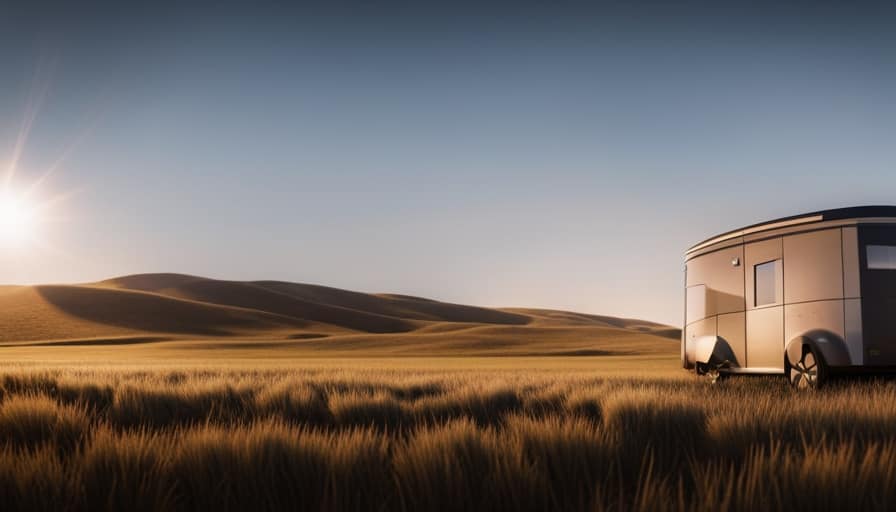
Speaking of personalization, let’s now delve into the next section about customizing our tiny abode: design modifications for functionality and style.
Customizing Your Tiny Abode: Design Modifications for Functionality and Style
When it comes to customizing our tiny abode, we’ve a plethora of design modifications at our fingertips. One of the most crucial aspects is space-saving storage solutions, allowing us to maximize every square inch.
With creative layout options, we can create a functional and efficient living space that suits our specific needs.
And of course, let’s not forget about adding our personalized aesthetic touches to make our tiny house truly feel like home.

Space-Saving Storage Solutions
Our tiny house on wheels includes several space-saving storage solutions to maximize functionality and style. When designing our compact abode, we prioritized efficient organization and clever storage options to ensure every inch of space is utilized to its fullest potential.
One of the innovative solutions we incorporated is hidden compartments. These discreet storage spaces are strategically placed throughout the house, blending seamlessly with the overall design while providing ample room to store belongings. From built-in drawers beneath the stairs to concealed cabinets behind decorative panels, these hidden compartments allow us to keep our living area clutter-free while still having easy access to our essentials.
Creative Layout Options
While considering the design modifications for functionality and style, it’s important to explore creative layout options for customizing your tiny abode.
One of the key factors in making the most of your limited space is choosing multifunctional furniture. These cleverly designed pieces serve multiple purposes, such as a sofa that can also be a bed, or a dining table that can be folded away when not in use. By incorporating multifunctional furniture into your tiny house on wheels, you can maximize the functionality of each room without sacrificing style.
Additionally, space optimization is crucial in a tiny home. This can be achieved through thoughtful placement of furniture, utilizing vertical space with storage solutions, and using clever design tricks like built-in shelving and hidden compartments.
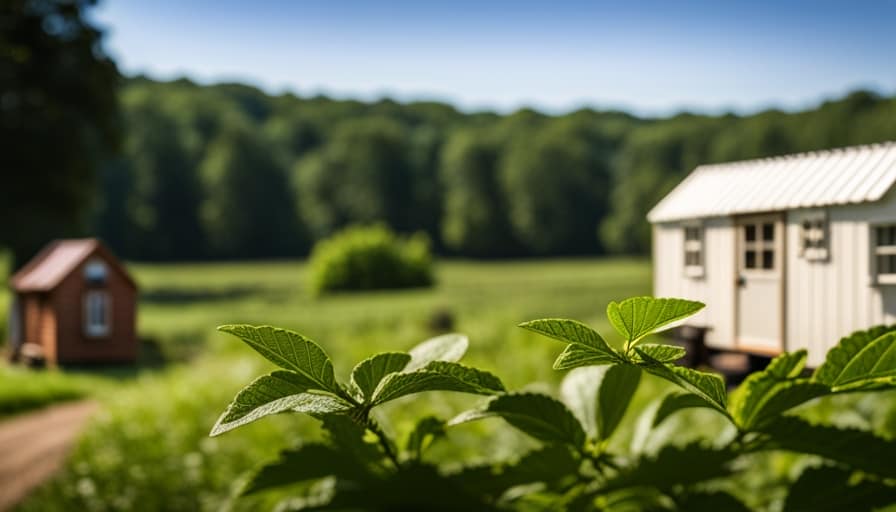
With creative layout options, you can create a personalized and functional living space that suits your needs and reflects your style.
Personalized Aesthetic Touches
By adding unique decorative elements and carefully selecting color schemes, we can enhance the personalized aesthetic of our tiny house on wheels and create a space that truly reflects our style and personality. Here are some ideas to inspire your personalized decor and create a unique style for your tiny abode:
-
Wall Art: Hang artwork or photographs that hold sentimental value or evoke a sense of adventure. Consider using floating shelves to display small trinkets or plants.
-
Textiles: Choose cozy throw pillows, blankets, and curtains that add texture and comfort to your space. Opt for patterns and colors that resonate with your personal taste.

-
Lighting: Install creative lighting fixtures that not only provide functionality but also serve as decorative pieces. String lights or fairy lights can create a whimsical ambiance.
-
Plants: Bring the outdoors inside by incorporating potted plants or a vertical herb garden. Not only do they add a pop of color, but they also improve air quality.
With these personalized touches, your tiny house on wheels will become a sanctuary that reflects your unique style and creates a welcoming atmosphere for both you and your guests.
Efficient Use of Space: Maximizing Comfort and Storage in a Tiny House on Wheels
We can achieve an efficient use of space in our tiny house on wheels by incorporating clever design modifications that maximize both comfort and storage.
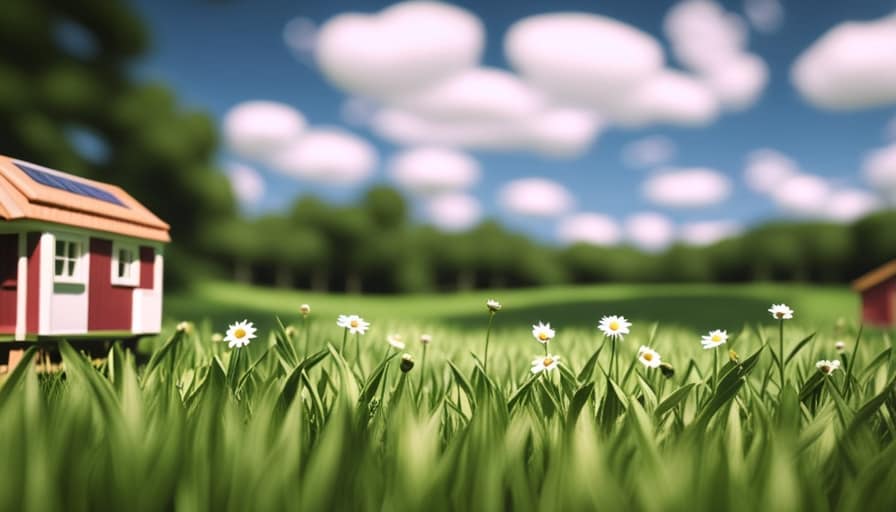
When it comes to maximizing functionality, every inch counts. One innovative storage solution is utilizing hidden compartments and multi-functional furniture. For example, a sofa with built-in storage underneath or a dining table that can be folded down when not in use.
Additionally, vertical space shouldn’t be overlooked. Installing shelves or cabinets that reach the ceiling can provide ample storage without taking up valuable floor space.
Another tip is to utilize the walls by adding hooks or magnetic strips to hang items like utensils, keys, or even pots and pans.
Off-Grid Living: Sustainable Solutions for Power, Water, and Waste Management
Our tiny house on wheels can achieve off-grid living with sustainable solutions for power, water, and waste management. Here are four eco-friendly solutions that allow us to live sustainably:
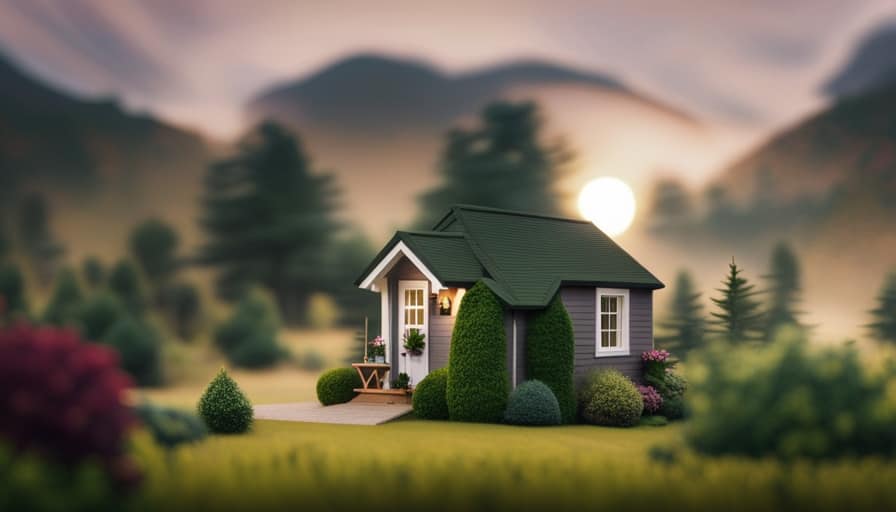
-
Solar Power: We’ve installed solar panels on the roof of our tiny house to harness the power of the sun. These panels convert sunlight into electricity, providing us with a sustainable energy source. We can power our appliances, charge our devices, and even heat water using solar power.
-
Rainwater Harvesting: To minimize our reliance on traditional water sources, we’ve implemented a rainwater harvesting system. This system collects rainwater from the roof and stores it in tanks. We can then use this water for various purposes, such as showering, washing dishes, and watering plants.
-
Composting Toilet: Instead of using a traditional flush toilet, we’ve opted for a composting toilet. This eco-friendly solution converts human waste into nutrient-rich compost, which can be used to fertilize plants. It significantly reduces water consumption and eliminates the need for a septic system.
-
Greywater Recycling: We’ve also implemented a greywater recycling system. Greywater is the wastewater generated from activities like showering and washing dishes. Instead of letting it go to waste, we collect and treat this water. It can then be reused for purposes like toilet flushing or watering non-edible plants.

Mobility and Flexibility: Embracing a Nomadic Lifestyle With a Tiny House on Wheels
One of the key advantages of a tiny house on wheels is the ability to travel and embrace a nomadic lifestyle. With a tiny house, you have the freedom to explore new places and live a life of constant adventure.
Embracing minimalism is an essential aspect of this lifestyle, as it allows you to prioritize experiences over material possessions. By downsizing and simplifying your life, you can focus on what truly matters and create a more meaningful existence.
Additionally, tiny houses on wheels offer sustainable travel options. You can choose to live off-grid, utilizing renewable energy sources and reducing your carbon footprint. This mobility and flexibility not only allows you to see the world, but also contributes to a more environmentally conscious way of living.
Financial Freedom: Cost-Effective Living and Minimalist Budgeting in a Tiny House on Wheels
When it comes to financial freedom, living in a tiny house on wheels offers numerous benefits.

Not only can you save a significant amount of money on housing, but you can also simplify your entire financial life.
Saving Money on Housing
We can significantly cut down on housing expenses by opting for a tiny house on wheels. Living in a tiny house not only promotes frugal living but also provides affordable housing options. Here are four ways a tiny house on wheels can help us save money:
-
Reduced utility costs: With a smaller space to heat, cool, and power, our monthly utility bills will be significantly lower. We can enjoy the benefits of modern amenities while keeping our energy consumption and costs to a minimum.
-
Minimal maintenance expenses: A smaller living space means fewer repairs and maintenance tasks. We can save money on maintenance and renovations, allowing us to allocate our funds to other priorities.
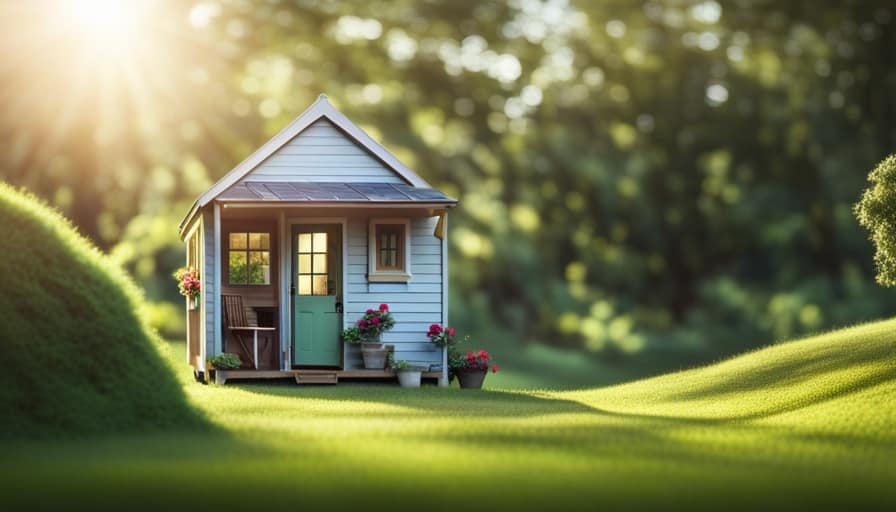
-
Lower property taxes: Tiny houses on wheels are often classified as recreational vehicles, which means we may be eligible for lower property taxes. This can help us save a significant amount of money each year.
-
Freedom from mortgage: By choosing a tiny house on wheels, we can avoid the burden of a mortgage. Instead, we can allocate our finances towards experiences, travel, and personal growth, giving us a sense of financial freedom and flexibility.
Living in a tiny house on wheels not only offers financial benefits but also promotes a minimalist lifestyle, allowing us to focus on the things that truly matter.
Simplifying Your Financial Life
Living in a tiny house on wheels allows us to simplify our financial life and achieve cost-effective living through minimalist budgeting. By embracing a minimalist lifestyle, we can prioritize the things that truly matter to us and eliminate unnecessary expenses. When it comes to budgeting, simplicity is key. We can create a minimalist budget by focusing on three main categories: housing, transportation, and daily expenses.
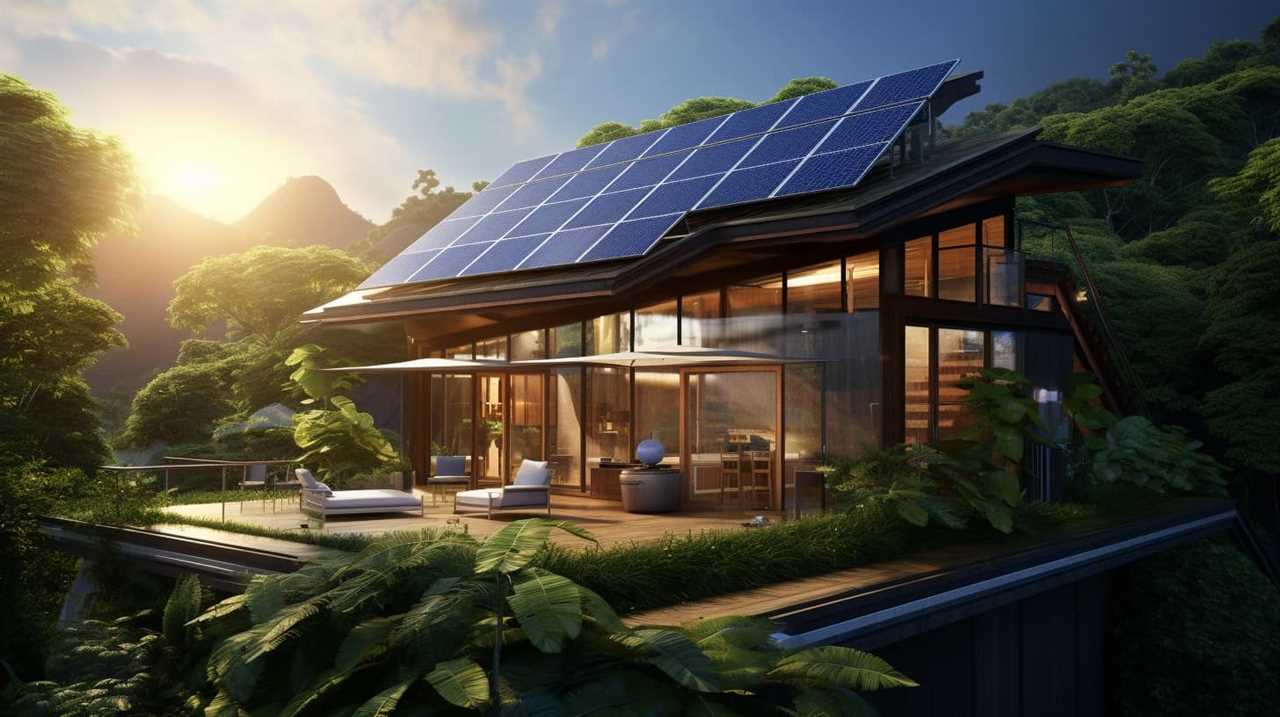
| Category | Monthly Budget |
|---|---|
| Housing | $500 |
| Transportation | $200 |
| Daily Expenses | $300 |
With a simplified budget, we can allocate our resources efficiently and have a clear understanding of our financial situation. Moreover, living in a tiny house on wheels significantly reduces housing and transportation costs, allowing us to save more and live within our means. This financial freedom allows us to pursue our passions, travel, and serve others without the burden of excessive financial obligations. Simplifying our budgeting and embracing minimalist living in a tiny house on wheels brings us closer to a life of financial freedom and fulfillment.
Overcoming Challenges: Tips and Strategies for Living in a Tiny House on Wheels
How can we successfully navigate and overcome the challenges of living in a tiny house on wheels? Here are some tips and strategies to help you make the most of your space and create a functional and comfortable home:
-
Maximize vertical storage: Utilize wall-mounted shelves, hooks, and cabinets to free up valuable floor space and keep your belongings organized.
-
Invest in multi-functional furniture: Opt for furniture pieces that serve more than one purpose. For example, a sofa that can also be used as a guest bed or a dining table that can be folded away when not in use.

-
Use clever storage solutions: Get creative with storage options such as under-bed drawers, hanging shoe organizers, and magnetic strips for organizing small items like utensils and tools.
-
Embrace minimalism: Adopt a minimalist mindset and declutter regularly to maintain a clean and organized living environment. Consider donating or selling items that you no longer need or use.
Frequently Asked Questions
How Much Does It Cost to Build a Tiny House on Wheels?
Building a tiny house on wheels can have a wide range of costs depending on factors such as size, materials, and finishes. Financing options like personal loans or RV loans can help with the cost breakdown.
Are There Any Legal Restrictions or Regulations for Living in a Tiny House on Wheels?
Legal challenges and zoning regulations are important considerations when living in a tiny house on wheels. It’s crucial to research and adhere to local laws to ensure a smooth and legal living experience.

Can a Tiny House on Wheels Withstand Extreme Weather Conditions?
Yes, a tiny house on wheels can withstand extreme weather conditions. Its weather resistance and structural stability make it a reliable and secure shelter, providing peace of mind no matter what Mother Nature throws at us.
What Are the Maintenance Requirements for a Tiny House on Wheels?
Maintenance requirements for a tiny house on wheels include regular cleaning, checking for any leaks or damage, and ensuring proper functioning of utilities. Storage solutions are essential to maximize space and keep belongings organized.
How Do You Deal With the Lack of Privacy in a Tiny House on Wheels?
When it comes to dealing with the lack of privacy in a tiny house on wheels, we’ve got you covered. Our ingenious privacy solutions and space-maximizing designs ensure that you can enjoy your personal space, no matter how small.
Conclusion
In the journey of life, a tiny house on wheels becomes our faithful companion, offering us the freedom to explore, customize, and maximize our space.

It empowers us to embrace a nomadic lifestyle while providing sustainable solutions for off-grid living.
With its cost-effective nature and minimalist budgeting, it grants us financial freedom.
Though challenges may arise, we can overcome them with determination and creativity.
Let our tiny house on wheels be our vessel of adventure, comfort, and endless possibilities.
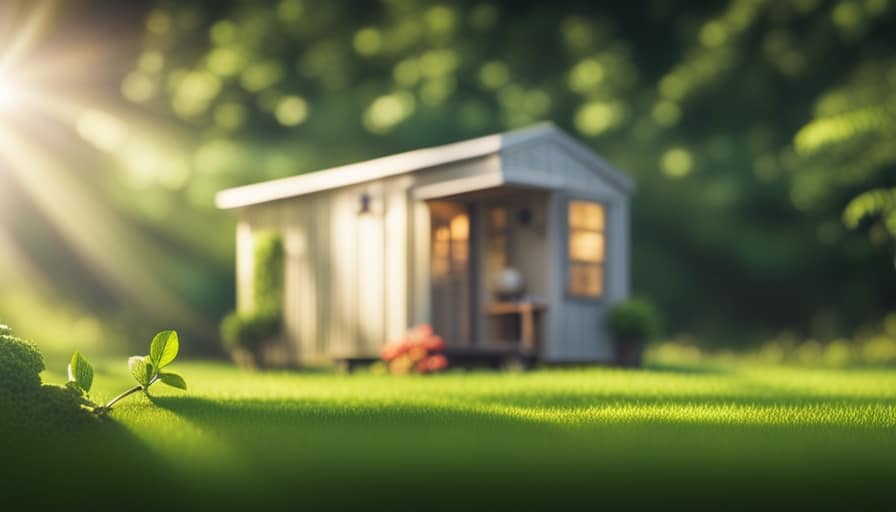
I’m Theodore, and I love tiny houses. In fact, I’m the author of Tiny House 43, a book about tiny houses that are also tree houses. I think they’re magical places where imaginations can run wild and adventures are just waiting to happen.
While tree houses are often associated with childhood, they can be the perfect adult retreat. They offer a cozy space to relax and unwind, surrounded by nature. And since they’re typically built on stilts or raised platforms, they offer stunning views that traditional homes simply can’t match.
If you’re looking for a unique and romantic getaway, a tree house tiny house might just be the perfect option.

